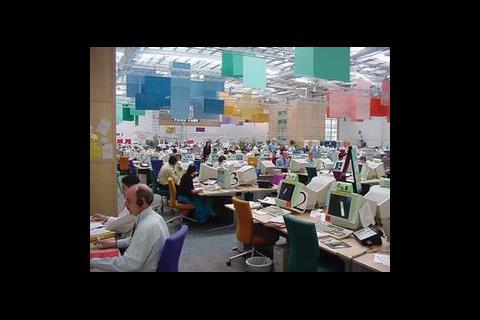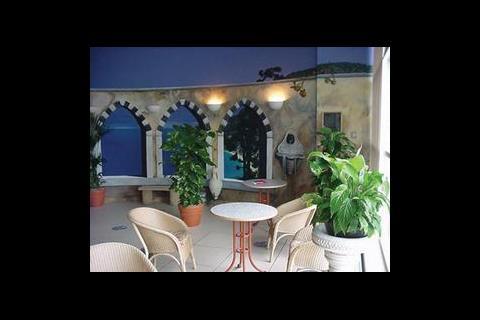Almost two years after its first call centre cost model, Building revisits Egg’s Pride Park, updating the whole-life costs and comparing it with a model call centre by Citex
<b>
- The call centre market</b>The call centre market in the UK has remained a significant sector of the economy since the last whole-life cost model on call centres (23 July 1999, pages 72-79). Indeed, Britain is Europe’s largest market for call centres, with a third of the total 750,000 agent places. Enabled by advances in technology, call centres have developed in their present form only since the early 1990s, but there are already more than 5000 in the UK.
- As shown in the table below, growth in the number of call centres has exceeded 12% annually from 1996 to 2000, and is expected to increase by about 11% per year between 2001 and 2005.
- Some key factors include:
- The UK is following the US, where a high proportion of call centre functions are outsourced. Three companies are leading the way: Applied Decision Systems, Sitel Europe and the Merchants Group.
- Many call centres operate shift systems so that up to three people can occupy a single workstation. Agent numbers may well have been underestimated as a consequence – some studies suggest that more than 400,000 people are employed in the industry.
- Four sectors dominate the call centre market: services, finance, telecoms and insurance. Between them, they account for about two-thirds of the market.
- Outbound calling (telesales) accounts for 23% of call centre activity and is the fastest growing sector.
- The greatest concentration of call centres is in Scotland (38%) and London and the South-east (31%).
- With the benefit of lower staff costs, several Asian countries (led by India) are competing actively for the UK’s call centre market.
- Growth in virtual call centres, relying on homeworking, is anticipated.
<B>Staff turnover</b>
With staff costs being the most significant expenditure – typically accounting for 60% of operating costs – the design of an effective environment to increase staff retention has a very early payback. For example, a 450-seat call centre that increases staff retention from one to four years can save more than £2m per year.
Staff turnover has been a major problem – some firms report 80% per year, but the average is falling and is now believed to be nearer 20%. Absenteeism is relatively high at more than 5%.
These staff recruitment and retention problems have caused many call centre operators to focus on working conditions and career opportunities, says Evan Kirchheimer, senior analyst at market research company Datamonitor. “Poaching is more common so employers can’t afford to treat their staff like cattle,” he says.
Dave Thomson, marketing manager at Aspect Communications, adds: “Training costs are horrendous, and if you are having to replace 30% of your staff each year, that’s expensive. The next big battle in the call centre market will be won by those companies with the best agents.”
<B>
- How Egg cracked the call centre </b>Launched in October 1998, Egg is an e-commerce company created by Prudential, the UK-based financial services company. It has more than 1 million customers. As one of the more recent entrants into the market, Egg has learned lessons from some of the earlier companies, highlighted above. In particular, it has focused much of its efforts on running efficient call centres, where the vast majority of its 2000-plus staff are employed.
- According to Pete Andrews, head of locations and infrastructure for Egg: “One of the key drivers has been the desire to have world-class call centres, with a conscious effort to insert a ‘wow’ environment in order to retain a loyal staff. At the same time, we have ensured that we obtain best value, never letting space be an obstacle and ensuring maximum flexibility to accommodate rapidly changing business needs. This includes the extensive use of hot-desking.”
- The benefits of designing an appropriate building from the outset are shown by the fact that, although virtually all of the staff at Pride Park have been relocated during its first two years, only 5-10% of the desks have been moved as a result of the modular structure. Staff exit interviews confirm that the building itself has played no part in their decision to leave, and staff turnover is lower than the industry norms.
- <B>
- Pride Park, Derby</b>The Egg building in Derby is one of the largest purpose-designed communications centres ever completed in the UK. At about 13,000 m2, the building can accommodate up to 1250 workstations and ancillary support facilities. Speed of delivery and a flexible interior was critical for the effective operation of the call centre. As a result, the building was procured using construction management and most of the structure was built and fitted out in less than a year. It opened in July 1999.
- The effectiveness of the concept has been recognised by being nominated overall winner in the recent The Times and Gestetner Digital Office Collection Awards, which named 100 of the UK’s most creative and ‘feel good’ offices for the digital age. A recent article (6 February) on www.business2.co.uk described it as follows: “Egg’s call centre in Derby, where architects DEGW designed a ‘city within a building’ for the 1000 staff. The open-plan area is broken up into ‘neighbourhoods’ using shapes, colours and visual landmarks rather than walls. Staff can choose between cube-shaped active breakout areas to ‘energise’ playing pool or table football, or dome-shaped passive areas for quiet contemplation. Managers no longer command from ivory towers, instead they sit with their staff, enabling them to be more involved in day-to-day activities.”
- Most of the Pride Park redevelopment has been constructed on seriously contaminated land, so a full methane barrier was installed under the foundations. The project was a catalyst for regeneration in the area, attracting further investment and development.
- The large interior covers an area the size of two football pitches – indeed, during the topping-out ceremony, the contractors held an indoor football tournament within one wing. The size and layout of each of the two wings of the main building – an almost-square, column-free space to accommodate at least 700 employees – was determined by Egg’s workstation configuration of clusters of 11.
- The steel-framed shell is clad with Kingspan panelling and curtain walling with a height to haunch of 10 m. A huge 42 m span provides the ultimate in internal flexibility. A raised floor with a 600 mm void accommodates the electrical trunking, fibre-optic cabling and displacement ventilation ductwork. Users can access data, telecoms and power virtually anywhere within the building.
- Computer and support facilities represent some 2600 m2 of space, and a similar area has been set aside for training and the staff restaurant. Printing, imaging and post rooms occupy nearly 2000 m2, along with 1921 m2 of plant rooms.
- In keeping with the focus on staff, the main halls have eight relaxation areas for employees’ breaks. All are fitted out like cafe bars and some are themed: one, for example, has the look of a Tuscan castle. Others are equipped with pool tables, arcade machines and table football. Four of the eight spaces are designed to be quiet, reflective spaces, ideal for reading or relaxation; the others are noisy, vibrant spaces where people can let off steam.
- <B>
- Comparison with model building</b>The earlier call centre article was based on the anticipated whole-life costs of Egg’s Pride Park building. With the benefit of the first full year
- of operation, it is now possible to produce a more accurate picture of the true costs of running a dedicated call centre building. The comparison is made with a traditional multistorey brick-clad office, which has been modified to accommodate a call centre. This offers sufficient space for 950 people in a 9850 m2 building. It is drawn from data gathered from other call centres in which Citex has been involved.
- Egg’s purpose-built call centre in Derby is considerably cheaper over 25 years that the traditional office building (table, pages 64-65). While the extensive fit-out undertaken at Pride Park has resulted in slightly higher capital costs, this is more than outweighed by the considerably lower revenue costs, reflecting the flexibility of the design. There is also the intangible benefit to the client of a more flexible building.
- The overall saving is 20% each year on a m2 basis and 25% on a workstation basis. The key areas of saving are:
- Rent, rates and service charge: reflecting the value of a typical distribution/industrial building against a traditional office
- Cleaning: layout and economies of scale
- Catering: economies of scale: fixed costs per site
- Central file servers: fixed costs per site.
<B>Capital and finance</b>
The fit-out costs include fees. Legal charges, abnormal ground conditions, VAT and capital allowances are excluded. Finance costs have been assumed at 5%.
<B>Occupancy</b>
These costs have been estimated at today’s prices over 25 years.
The costs are assumed to be price-neutral and no allowance has been made for changes in market conditions or legislation. The costs include planned and cyclical maintenance, cleaning, external landscaping, 24-hour security, an 18-hour helpdesk, porterage, a post room, internal planting, external landscaping, churn (reconfiguration of offices), IT and management.
<b>
- Methodology</b>
- This whole-life cost model has been compiled by Brendan Patchell and Nick Thomas of Citex, with extensive assistance from Egg, particularly Pete Andrews. The model building figures are based on Citex’s extensive portfolio across the UK. For more details, please contact Brendan Patchell on 0121-214 8060 or Nick Thomas on 0121-214 8206.
Credits
project manager
Citex Project Delivery
architect
DEGW
quantity surveyor
Citex Bucknall Austin
services engineer
ES Consulting
structural engineer
John Nolan Associates
construction manager
Citex Project Delivery
mechanical consultant
Haden Young
electrical consultant
NG Bailey
main contractor
B&K Building Services


























